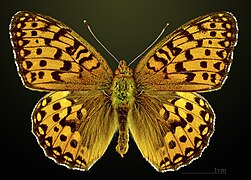Large mother-of-pearl butterfly
| Large mother-of-pearl butterfly | ||||||||||||
|---|---|---|---|---|---|---|---|---|---|---|---|---|

Great mother-of-pearl butterfly ( Speyeria aglaja ), female |
||||||||||||
| Systematics | ||||||||||||
|
||||||||||||
| Scientific name | ||||||||||||
| Speyeria aglaja | ||||||||||||
| ( Linnaeus , 1758) |
The great mother-of-pearl butterfly ( Speyeria aglaja , syn .: Argynnis aglaja ) is a butterfly (day butterfly ) from the family of the noble butterfly (Nymphalidae). The specific epithet is derived from Aglaia , one of the three graces from Greek mythology .
features
The moths reach a wingspan of 50 to 55 millimeters and are one of the largest European mother-of-pearl butterflies with their size, which is slightly smaller than that of the imperial mantle ( Argynnis paphia ) . They have orange or yellow-brown wing tops that are patterned with black spots and transverse bands. The wing edge is broadly lined with dark. Behind it are triangular spots that extend into the black border. The wing undersides of the hind wings are yellow-brown, in the two inner thirds, or in the basal half, they are slightly greenish and have numerous, light mother-of-pearl spots. Light spots are also lined up on the outer edge of the wing. The undersides of the forewings are more orange in color and have black spots. The males have scent scales on three slightly widened longitudinal arteries in the rear part of the forewings , which release pheromones to attract females.
△ Large mother-of-pearl butterfly
The caterpillars are about 38 millimeters long. They are black and have rows of red-orange dots on each side. Young caterpillars are also shown in white. The caterpillars have long, black and branched thorns.
Systematics
The specific epithet aglaja comes from the ancient Greek word ἀγλαΐα, which means shine, splendor. In 1758, Carl von Linné gave the name Papilio aglaja twice, first to a white from Southeast Asia, now known as Delias aglaja , then to the great mother-of-pearl butterfly. Linnaeus recognized his mistake and in 1767 replaced the white name with Papilio pasithoe , which according to the nomenclature rules only led to a synonym. The great mother-of-pearl butterfly is also known under the synonym Mesoacidalia aglaja , L.
Occurrence
The animals are found all over Europe , Morocco and almost all of Asia as far as Japan . Their distribution extends to around 2,200 m above sea level. They live in forests but also in open areas such as B. on meadows, heaths , moors and dry grasslands . They prefer basic soils and are not uncommon, but in places they are clearly in retreat.
Flight and caterpillar times
They fly in one generation from June to August.
Food of the caterpillars
The caterpillars feed on violet species ( Viola ), especially rough violets ( Viola hirta ), but also dog violets ( Viola canina ) and swamp violets ( Viola palustris ).
development
The females lay their eggs one by one on the stems and undersides and tops of the leaves of their forage plants. The caterpillars that hatch after two to three weeks only eat the eggshells and then go into hibernation immediately afterwards. Their development will not begin until next year. They pupate in brown tumbled pupae , which do not have silver stains, on the stem close to the ground.
swell
literature
- Hans-Josef Weidemann: Butterflies: observe, determine . Naturbuch-Verlag, Augsburg 1995, ISBN 3-894-40115-X .
Individual evidence
- ^ Robert S. De Moya et al .: Interrelationships and diversification of Argynnis (Fabricius) and Speyeria (Scudder) butterflies . In: Systematic Entomology . tape 42 , 2017, p. 635-649 , doi : 10.1111 / syen.12236 .
- ^ Arnold Spuler: The butterflies of Europe . tape 1 . E. Schweitzerbartsche Verlagbuchhandlung, Stuttgart 1908, p. 30 .
- ↑ a b c d e Heiko Bellmann : The new cosmos butterfly guide. Butterflies, caterpillars and forage plants. Franckh-Kosmos, Stuttgart 2003, ISBN 3-440-09330-1 , p. 160.
- ↑ F. Hemming. On the correct name of the species commonly known as Argynnis aglaja (Linnaeus, 1758) (Lep. Nymphalidae) and matters incidentally. Proceedings of the Royal Entomological Society of London. Series B, Taxonomy, Volume 11, 1942, pp. 155-160. doi : 10.1111 / j.1365-3113.1942.tb00715.x
- ↑ a b Tom Tolman, Richard Lewington: The butterflies of Europe and Northwest Africa . S. 152, Franckh-Kosmos Verlags-GmbH & Co, Stuttgart 1998, ISBN 3-440-07573-7
Web links
- Lepiforum e. V. Taxonomy and Photos
- www.schmetterling-raupe.de
- Moths and Butterflies of Europe and North Africa (English)
- Argynnis (Mesoacidalia) aglaja at Fauna Europaea



